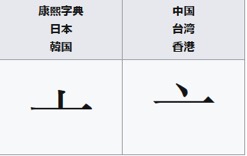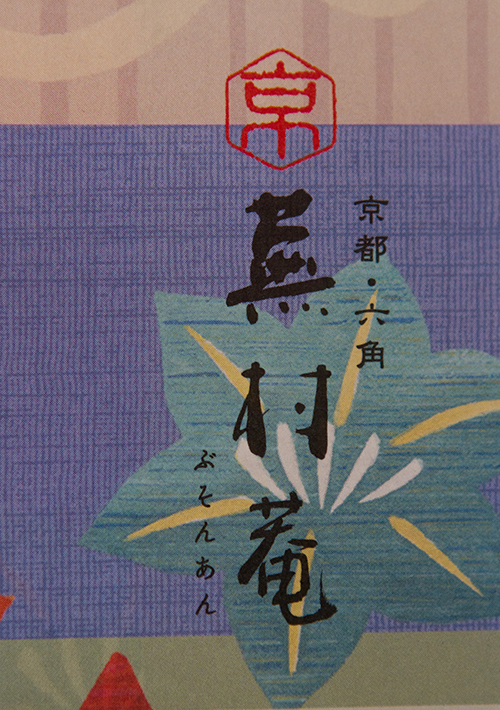8. The "Lid" Radical: 亠
The "lid" radical 亠 looks quite simple with its two rectilinear strokes. You can see it clearly atop this kanji:
京 (99: capital; Tokyo; Kyoto)
The English radical name "lid" is also entirely straightforward, as is the alternate name "kettle lid." But the Japanese names for this radical stir the pot, so to speak.
What Do the Japanese Call the "Lid" Radical?
Look at all of these possibilities:
• なべぶた (鍋蓋), which means "pot lid." The Japanese (not the Chinese) came up with this name, and it's the one I'll use.
• てんいち, describing 亠 as a combination of radicals 3 and 1:
radical 3: 丶, the "dot" radical, pronounced as てん
radical 1: 一, the "one" radical, read as いち
Nelson includes this radical name, but Kanjigen does not, probably because (according to Wikipedia) Japan and South Korea use the inverted-T shape of this radical (see column 1 below), whereas China, Taiwan, and Hong Kong go with a dot + horizontal stroke (as shown in column 2):

• けいさん (卦算), which starts with a non-Joyo kanji. Uncommon as both a word and a radical name, this term means "paperweight used in Japanese calligraphy," referring to something shaped like this:

By the way, the Japanese usually call this object a 文鎮 (ぶんちん), as you can see at the Amazon link for this product. The word 卦算 apparently comes from the way this paperweight resembles 算木 (さんぎ: lit. “calculation wood"), wooden rods used to calculate (算) divination signs (卦) in Chinese fortune telling.
• けいさんかんむり (卦算冠), which means "paperweight in the crown position of a kanji." In other words, this term refers to 亠 on top of a character.
Where Is the "Lid" Radical Located in Joyo Kanji?
The last radical name could make one ask whether 亠 ever appears anywhere other than the top of a kanji. In the five Joyo kanji featuring this on-duty radical, 亠 crowns each one. In addition to 京 (99: capital; Tokyo; Kyoto), we have these four kanji:
交 (115: association; exchange; cross; to blend; deliver; by turns)
亡 (973: to die; ruin; escape)
享 (1162: to enjoy; receive)
亭 (1614: house; pavilion; name suffix)

Photo Credit: Dorothy Brown
My husband's Japanese colleague gave us a gift in this beautiful wrapping paper. The large red character at the top of the image is 京 (99: capital; Tokyo; Kyoto) in seal script. The big black characters down the center of the packaging are 蕪村庵 (ぶそんあん), the name of a Kyoto shop selling senbei (rice crackers). Only the middle kanji in that name is in the Joyo set (and the shop was likely named after the famous poet Buson Yosa).
The right-hand column starts with 京都 (きょうと: Kyoto), followed by 六角 (ろっかく: hexagon). A hexagon? Yes, the main branch of 蕪村庵 is on a street called 六角通 or 六角通り (both ろっかくどおり). The name comes from that of the temple building 六角堂 (ろっかくどう), which is on the same street. The roof of that building is actually hexagonal. So it is that we find the red character in a hexagon on the packaging, collectively constituting the store's logo!
Note that our radical is not on duty in 六. Instead 六 (six) is categorized under the 八 ("eight" radical), which is radical 12! That sounds like a riddle!
Photo Credit: Corey Linstrom
Our radical makes two appearances on this sign, both in the line across the top and in the red teardrop-shaped image. The following kanji feature that radical:
交 (115: association; exchange; cross; to blend; deliver; by turns)
亡 (973: to die; ruin; escape)
Here's the top line:
昨日の交通事故
Yesterday's Traffic Accidents
昨日 (きのう: yesterday);
交通事故 (こうつうじこ: traffic accident)
The rest of the sign constitutes a table. Here are the column heads:
都内 (とない: within the Tokyo metropolitan area)
管内 (かんない: within the jurisdiction of the police station)
The teardrops contain these words:
死亡 (しぼう: death)
負傷 (ふしょう: injury)
So the right-hand column of this particular sign means that yesterday, in the area under the jurisdiction of the police station (管内), no one was killed in traffic accidents, though two were injured. By contrast, one person died and 140 were hurt in vehicle crashes in all of Tokyo (都内) yesterday. Such statistics are on display at nearly every police station or police box in Japan.
Which Radicals Contain the 亠 Shape?
Looking for instances of the 亠 radical has made me aware of just how many other radicals contain that shape. Spotting 亠 in various characters might make you think you've found more examples of our radical, but in fact you're seeing a different radical each time. Here are some examples (and the list is incomplete!):
| 宀 (40: "katakana u" radical) | 疒 (104: "sickness" radical) |
| 广 (53: "dotted cliff" radical) | 穴 (116: "hole" radical) |
| 支 (65: "branch" radical) | 立 (117: "standing" radical) |
| 文 (67: "literature" radical) | 衣 (145: "clothing" radical) |
| 方 (70: "direction" radical) | 赤 (155: "red" radical) |
| 玄 (95: "blackness" radical) | 辛 (160: "bitter" radical) |
Photo Credit: Eve Kushner
This restaurant name looks odd because 放心 (ほうしん) primarily means "absentmindedness." That's just the quality one wants in a server! A rare second meaning is "peace of mind." One would hope that that's the sense that applies here!
We see our radical in 亭 (1614: house; pavilion; name suffix), which functions here as a restaurant name suffix with the yomi -てい.
As for 放, its left-hand component made me wonder about the radical of the autonomous 方 kanji. As we just saw, the entire 方 shape is radical 70, the "direction" radical, and that radical is on duty in the 方 kanji.
Photo Credit: Eve Kushner
The last line of this sign includes the shop name 京宝亭 (きょうほうてい). Look at those matching tops! We've seen that the first and third characters contain our radical. As for 宝 (treasure), that features radical 40, 宀, the "katakana u" radical.
The shop, which no longer exists, specialized in つくだに (佃煮: preserved food boiled in a soy sauce mixture, in which 佃 is non-Joyo). A full explanation of the sign appears in essay 1614 on 亭.
